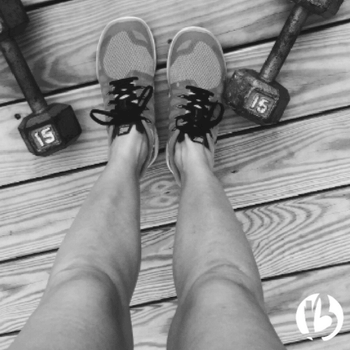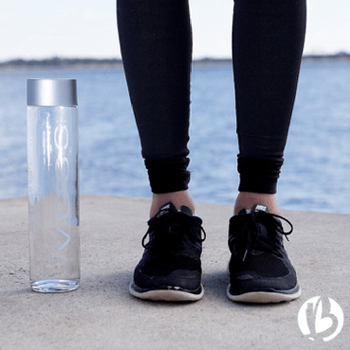Sore Muscles: 4 Tips for Workout Recovery
The benefits of weight training are amazing. By now, I think you know that.
But if you’re noticing sore muscles after weight training, you may have some questions.
Is this normal? What can I do to ease sore muscles?
First, let me assure you, yes it’s common to notice sore muscles after participating in a workout – especially if it’s something new to your body.

Mildly sore muscles is simply a natural outcome of any kind of physical activity.
And when you add in heavy weight training to the mix, you increase the likelihood of sore muscles.
Generally muscle soreness is most prevalent in the beginning stages of a program, but sore muscles can be experienced by anyone – even advanced athletes.
Sore Muscles: Delayed Onset Muscle Soreness
In the world of exercise physiology, we refer to the gradually increasing discomfort that occurs between 24 and 48 hours after activity as delayed onset muscle soreness (DOMS).
Not only is it normal, but it’s extremely common among women who lift weights.
DOMS results after an activity that stresses the muscle tissue beyond what it is accustomed to.
When your muscle contracts, you cause small microscopic tears occur in the muscle. This mild microscopic damage to the muscle fibers, in addition to the inflammation that accompanies these tears, is what causes sore muscles and is an indication that your muscles are adapting to your workout program.
Sore Muscles: Overtraining
Although sore muscles is common and not something to worry about provided the pain subsides after 24-48 hours, I’d fail to be a good coach if I didn’t give you some tips for workout recovery and encourage you to take advantage of the benefits of rest days.
Excessive recovery time prevents you from reaching your goals, that’s true. According to American Fitness Professionals and Associates, after 96 hours changes associated with muscle atrophy begin, and after a week of not training you can lose up to 10 percent of your strength.
But…without proper recovery time, weight lifting can be counterproductive.

Fatigue and decreased strength occurs when the body doesn’t get enough rest between weight-training sessions, or when the muscles haven’t fully recovered their glycogen stores.
High intensity resistance exercise can cause damage to skeletal muscle and connective tissues.
When muscle trauma occurs, it impairs the transport of blood glucose into the skeletal muscle cells, inevitably leading to soreness and pain.
Strength and fitness may regress if planned recovery time isn’t a part of your program.
Overtraining can lead to:
- injuries
- insomnia
- weight and strength fluctuations
- mood-swings
- declining endurance
- prolonged bouts of sickness
- tendinitis
- reduced concentration.
Your training history and weight lifted determine how much recovery time you need.
If you feel you have reached a plateau and are no longer furthering your improvements, it may be caused by over-training.
Pay close attention to our schedule and remember…
REST is part of the plan!
As a type AAA person myself, I like to be accomplishing stuff. For many years I had the mindset of “more is better” and ended up sabotaging my own progress. Since learning how to #dofitnessbetter, I’ve come to under that more is not better – BETTER is better.
So you’ll notice our training plans in the BeyondFit Life Club also includes plenty of rest days.

When you download and print your calendar, what you WON’T see on rest days is an instruction to sit in front of the television with a bowl of ice cream. (Although I do love a good netflix binge.)
Instead, I encourage you to do some low-impact, restorative exercise, such as leisurely walking, yoga, stretching, or foam rolling.
The key is to go light so the body adequately recovers from the previous workout.
Sore Muscles: Tips for Recovery
Muscle adaptations occur during recovery, and should be looked at as a part of your training. This is part of what you need to get to your goal. Whether you are just starting, or you’re an advanced athlete, taking time to recover will maximize your strength and help prevent injury.
If you’re experiencing sore muscles, some tips for recovery include:
REST DAYS
Generally speaking, women engaging in a heavy weight, full-body workout should take one to two days of rest between each session. That means no heavy weight training, but instead focusing on rest and recovery or low impact leisurely activities like walking, yoga, as mentioned above.

LIFESTYLE FACTORS
Lifestyle factors impact your body’s ability to recover. Seven to eight hours of sleep a night, balanced nutrition and a minimum of ½ your bodyweight in ounces of water are also necessary for your body to recover completely after a tough workout. Consuming complex carbohydrates increases the glycogen levels and should be consumed – along with a quick digesting source of protein – after a strenuous workout.

FOAM ROLLING
Self myofascial release with a foam roller is a technique you can use daily that will help you work out those tight areas; providing better muscle elasticity and higher performance. Fascia assists your muscles in dealing with heavy workloads, stress and injuries, but it can become knotted and tight due to repetition and overuse.
The uncomfortable sensation of an overly tight or overused muscle is also caused by knotted and tight fascia. When fascia is damaged, either due to lack of flexibility training or overuse, it can cause multiple problems such as muscle spasms, headache, numbness and even further reduced muscle flexibility. Here are six simple and easy lower body foam rolling moves that you can incorporate into your exercise routine.
Try and do these moves at least 3 times/week; preferably after exercise when your muscles are warm.

MASSAGE/ACUPRESSURE
Massage or acupressure tools help to relieve minor muscle aches and pains. To reduce muscle pain, you can use the mat or tool of your choice on specific areas of your body where you feel pain for 5-10 minutes.
If you’re looking for a good massage/acupressure tool, I love my pranamat. It features dozens of lotus-shaped massage stimulators that put gentle pressure on your problem areas to relieve minor aches, pains, and tension throughout your body—from head to toe.

Pranamat helps:
- Relieve muscle aches, pain, and tension
- Promote feelings of well-being
- Promote relaxation
- Improve sleep
After a session with Pranamat, many users report feeling happier, relaxed, and restored. There are many ways to use Pranamat ECO—for exercise, for improved sleep, after yoga or sports, and more.
Check out pranamat. BONUS: Use the code BEYONDFITMOM10 for 10% off your order!
Finally, if you’d like MORE help on foam rolling for sore muscles:
The BeyondFit Life Club makes these lifestyle changes, weightlifting workouts and sore muscle recovery so easy! All that and the most supportive group of accountability partners you’ll ever encounter! Join today!
